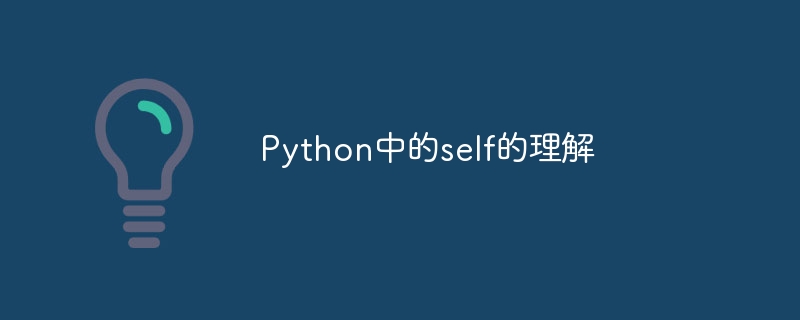Home >Backend Development >Python Tutorial >Understanding the self keyword in Python
Understanding the self keyword in Python
- PHPzOriginal
- 2024-02-20 11:27:06716browse

Understanding and examples of self in Python
In Python, self is a special parameter that is used to represent the instance object of the class itself. Through self, we can access the member variables and methods of the class in the class method. In this article, I will explain the role of self and how to use self correctly to access members of a class.
First, let us understand the concept of self. In Python, when defining a class, the first parameter is usually self. The self parameter points to the instance object of the class itself. When we create an instance object of a class and call a method of the class, Python automatically passes the instance object as a parameter to self. Through self, we can access and modify the member variables of the instance object in the method.
The following is a simple example that shows how to use self to access member variables of a class:
class Person:
def __init__(self, name):
self.name = name
def hello(self):
print("Hello, my name is", self.name)
p = Person("Alice")
p.hello() # 输出:Hello, my name is AliceIn the above code, we define a Person class, which has a name Member variables and a hello method. In the hello method, we access the name member variable of the instance object through self.name.
In addition, we can also use self to call other methods of the class. Here is an example that shows how to call a method within another method:
class Calculator:
def __init__(self, num1, num2):
self.num1 = num1
self.num2 = num2
def add(self):
return self.num1 + self.num2
def multiply(self):
return self.num1 * self.num2
def calculate(self):
sum = self.add()
product = self.multiply()
print("Sum:", sum)
print("Product:", product)
calc = Calculator(5, 3)
calc.calculate()In the above code, we define a Calculator class that has three methods: add, multiply, and calculate. In the calculate method, we use self.add() and self.multiply() to call other methods of the class.
It should be noted that when passing the instance object to self, there is no need to write it out explicitly. Python automatically passes the instance object to self. For example, when calling p.hello(), p will be automatically passed to self, which is equivalent to p.hello(p).
In addition, it should be noted that self is only used in class methods. We cannot use self to access member variables of a class elsewhere in the class, such as in the constructor of the class or in a static method of the class. In these places, we need to use instance objects to access member variables of the class.
To summarize, self is a special parameter in Python, which is used to represent the instance object itself of the class. Through self, we can access the member variables and methods of the class in the class method. Through the demonstration of the sample code, I believe that everyone has a full understanding of self and knows how to use self correctly in their own Python programs.
Note: The above examples are only to illustrate the role of self. Actual use may involve more complex logic and functions.
The above is the detailed content of Understanding the self keyword in Python. For more information, please follow other related articles on the PHP Chinese website!

